The Longmen Grottoes, located on the banks of the Yi River in the southern suburbs of Luoyang, are nestled between Longmen Mountain and Xiangshan Mountain. As one of the treasures of Chinese stone carving art, they are recognized as a UNESCO World Heritage Site, a National Key Cultural Relics Protection Unit, and a AAAAA-level tourist attraction. The Longmen Grottoes, together with the Mogao Grottoes in Dunhuang and the Yungang Grottoes, are celebrated as China's three great ancient grottoes.
The construction of the Longmen Grottoes began during the Northern Wei Dynasty (493 AD) and continued for over 400 years through successive dynasties. Stretching one kilometer from north to south, the site now boasts 2,345 caves and niches, more than 100,000 stone statues, over 2,800 inscriptions, and 60 pagodas.
The grottoes and niches showcase the most monumental and exquisite sculptural art of China from the late Northern Wei Dynasty to the Tang Dynasty (316–907 AD). These masterpieces, centered on Buddhist themes, represent the pinnacle of Chinese stone carving art. The "Central Plains style," characterized by its solemn elegance, and the "Tang Dynasty style," known for its grandeur and vitality, not only influenced artistic trends across China but also spread far beyond its borders, leaving a profound impact on the development of sculptural art in China and across Asia.
Having weathered more than a thousand years of history, the Longmen Grottoes continue to shine with timeless allure, captivating visitors from around the world. Today, they stand as an open invitation to friends from all corners of the globe, offering a glimpse into the profound depth and brilliance of Chinese civilization.
Opening Hours:
Peak Season
April 1 - October 7: 7:30 AM - 10:00 PM
October 8 - October 31: 7:30 AM - 6:00 PM
Off-Season
February 1 - March 31: 8:00 AM - 6:00 PM
November 1 - January 31: 8:00 AM - 5:30 PM
Visiting Route
West Mountain Grottoes → East Mountain Grottoes → Xiangshan Temple → Bai GardenOfficial phone number: 0379-6982 1222
Must-see Highlights
Fengxian Temple
Fengxian Temple is the largest and most artistically accomplished group of stone carvings in the Longmen Grottoes. Its construction began in 672 AD and took three years to complete, with the cave measuring over 30 meters in both length and width. The statues within the cave exemplify the distinctive style of Tang Dynasty Buddhist art: rounded faces, elongated ears, and serene, approachable expressions that exude a profound sense of warmth and tranquility.
The temple features nine large statues, with the central figure being the Vairocana Buddha, the embodiment of the Buddha Shakyamuni. According to Buddhist scriptures, "Vairocana" means "illuminating all things". This statue stands 17.14 meters tall, with a head height of 4 meters and ears measuring 1.9 meters in length. The entire figure resembles a wise and compassionate middle-aged woman, radiating both majesty and approachability. Its extraordinary artistic charm inspires awe and reverence in all who behold it.
Qianxi Temple
Qianxi Temple, the first cave temple at the northern end of Longmen's West Mountain, stands approximately 9 meters in both height and width, with a depth of nearly 7 meters. Dating back to the early Tang Dynasty over 1300 years ago, the temple features a shallowly carved lotus pattern adorning its ceiling. The principal Buddha, Amitabha, sits serenely on the Sumeru throne, his round face radiating wisdom and his gracefully draped robes complementing his well-proportioned figure, creating an aura of tranquil benevolence. The south wall showcases the Bodhisattva Mahasthamaprapta, whose full-bodied form and dignified posture are so remarkable that an exact replica is displayed in the Palace Museum. Together with the flanking Bodhisattvas, Amitabha forms the "Three Saints of the West," central to Pure Land Buddhism's devotional practice.
Lotus Cave
Lotus Cave, named after the magnificent high-relief lotus carved into its ceiling, dates back to the Northern Wei Dynasty. In Buddhism, the lotus symbolizes purity, representing the idea of "rising untainted from the mud." While lotus motifs commonly adorn the ceilings of Buddhist grottoes, the grand and exquisitely crafted high-relief lotus in this cave is a rare masterpiece among the Longmen Grottoes. Surrounding the lotus are gracefully posed Flying Apsaras, their slender waists and flowing robes captured in mid-motion with remarkable elegance. The iconic lotus ceiling of the Great Hall of the People in Beijing draws direct inspiration from this ancient artistic wonder.
Xiangshan Temple
Facing the Longmen Grottoes across the river, Xiangshan Temple was first built in 516 AD during the Northern Wei Dynasty. It was renamed "Xiangshan Temple" and extensively renovated in 690 AD under the patronage of Empress Wu Zetian, following a petition by her nephew Wu Sansi. The reconstructed temple, with its towering pavilions seemingly piercing the clouds, became a favored retreat for the Empress. In 832 AD, Bai Juyi, a renowned poet and governor of Henan, donated a substantial sum to restore the temple and housed over 5,000 volumes of Buddhist scriptures within its walls. Bai Juyi's deep connection with the temple culminated in his burial on its grounds in 846 AD, fulfilling his final wish.
Bai Garden
Bai Garden, situated on the Pipafeng Peak of Longmen's East Mountain, is the burial site of the renowned Tang Dynasty poet Bai Juyi. Spanning 30,000 square meters, it was designated a National Key Cultural Heritage Site in 1961. Bai Juyi spent the last 18 years of his life in Luoyang, captivated by the natural beauty of Longmen. The garden features over ten scenic spots, such as the Poetry Corridor and the Japanese Calligraphy Gallery. The Poetry Corridor houses 38 stone tablets inscribed with Bai Juyi's masterpieces, calligraphed by celebrated Chinese artists, offering a harmonious blend of literary and artistic excellence. The Japanese Calligraphy Gallery, opened in March 2000, showcases works by contemporary Japanese calligraphers, serving as a testament to the cultural exchange between China and Japan.
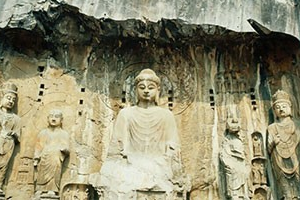
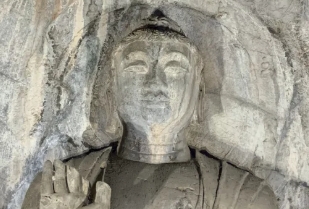
Things to Do
1. Stroll along the banks of the Yi River, marveling at the solemnity of the Vairocana Buddha and the grace of flying Apsaras, while appreciating the exquisite craftsmanship of ancient artisans and the profound depth of Buddhist culture.
2. Visit the Longmen Grottoes Museum to delve into the history, artistic features, and cultural significance of the grottoes, enriching your visit with deeper insights.
3. Night tour: Experience the magic of Longmen at night, as the illuminated grottoes transport you back to the grandeur of the Tang Dynasty, offering a unique sense of awe and wonder.
4.Glide along the Yi River on a boat, taking in the panoramic view of the Longmen Grottoes, where the harmony of nature and art creates an unforgettable spectacle.
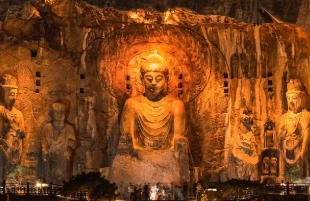
Best Time to Visit Longmen Grottoes
The best times to visit the Longmen Grottoes are spring (April-May) and autumn (September-October), when the weather is pleasant and the scenery is breathtaking.
In spring, the mountains are adorned with blooming flowers, while autumn paints the forests in vibrant hues, creating a perfect harmony with the ancient grotto art.
However, the beauty of the Longmen Grottoes is not confined to spring and autumn alone.
During summer, the lush greenery and cool waters of the Yi River offer a refreshing retreat from the heat.
In winter, the snow-covered grottoes take on a serene and majestic charm, offering a uniquely tranquil experience.
No matter the season, the Longmen Grottoes never fail to captivate visitors with their timeless beauty.
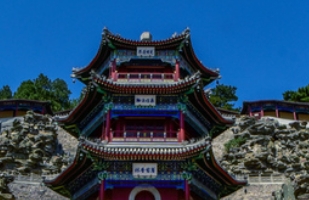
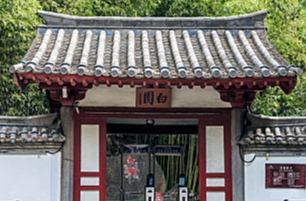
Transportation Guide
Visitors can take Bus 81 from Luoyang Railway Station, with the journey taking approximately 40 minutes.
Additionally, Buses 53, 81, and 60 from various locations in the city also provide access to the site.
For those traveling between the Longmen Grottoes and Shaolin Temple, a shuttle service is available for added convenience.
Within the scenic area, an electric cart service is offered for an additional fee, allowing visitors to explore the vast grounds with ease and comfort.
Travel Tips
Temperature&Dress advice:
Spring (March-May):
With noticeable temperature fluctuations between morning and evening, average temperatures range from 10-20°C. Light spring attire such as long-sleeved T-shirts, light jackets, and jeans is recommended. Don’t forget to pack a warm layer for cooler mornings and evenings.
Summer (June-August):
Hot and rainy, with average temperatures between 25-35°C. Opt for breathable, sweat-absorbing summer wear like short-sleeved T-shirts, shorts, or skirts. Be sure to take sun protection measures, such as applying sunscreen, wearing a hat, and using sunglasses.
Autumn (September-November):
Cool and refreshing, with temperatures gradually dropping to an average of 15-25°C. Comfortable autumn clothing like long-sleeved T-shirts, light sweaters, and jackets is ideal. A light down jacket is advisable for cooler mornings and evenings.
Winter (December-February):
Cold and dry, with average temperatures ranging from 0-10°C. Bundle up in warm winter wear such as down jackets, sweaters, and thermal underlayers. Accessories like hats, scarves, and gloves are essential to stay cozy.
Note:
It is advisable to book tickets in advance, especially for the enchanting Night Tour of Longmen.
Exploring the scenic area on foot takes approximately 3 hours, so comfortable walking shoes are a must for a pleasant experience.
During summer visits, be sure to take precautions against mosquitoes and insects to fully enjoy your time.



































